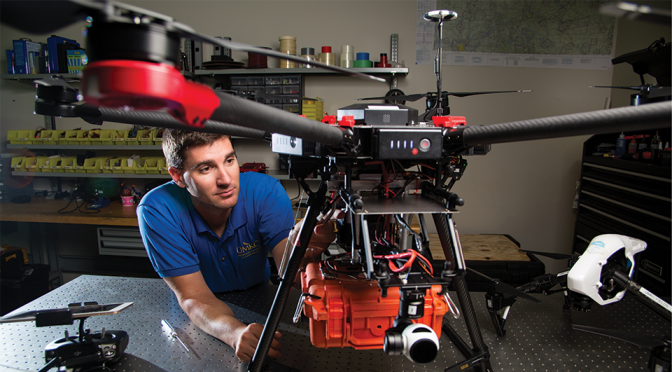For Travis Fields, Ph.D., drones are more than last year’s holiday gift craze; they are a way of life. As an assistant professor of mechanical engineering in the School of Computing and Engineering, he is excited to be taking research with drones and unmanned aircraft to new heights.
“I am a private pilot and have always been fascinated by aircraft and aerospace, so finding a unique and interesting area to do research with drones was an easy pick,” he says.
Drone technology is growing far beyond personal and commercial use. While large companies like Amazon are turning to drones for innovative package delivery and business solutions, Fields is eager to explore the practical and even life-saving capabilities of this relatively new technology.
“I don’t think that Amazon Prime Air will radically change our lives, but drone use for areas such as bridge inspection, search-and-rescue missions and logistical operations like fire-fighting and evacuations have the potential to reduce risk to human life, increase efficiencies, reduce costs and improve safety,” Fields says.
In 2015, Fields had the opportunity to explore drone capabilities in a groundbreaking way after receiving a FastTrack award from the University of Missouri System Office of Research and Economic Development. The grant provided funding to advance Fields’ innovative technology for drone-based bridge inspections. Fields teamed up with a local engineering firm, Shafer, Kline and Warren, Inc., and the Missouri Department of Transportation to use drones to determine the viability of area bridges. The goal of the project was to field test a tethered drone system the team created. This prototype enabled an operator to expand the typical flight time of a drone from 15 minutes to eight hours or more by providing power through the tether with a gas generator and a battery backup.
“We performed two sets of field tests, and our inspection capabilities dramatically increased over the existing technologies offered,” Fields says. “Our effort led to the closure of a structurally unsafe bridge, as our video data provided the first clear indications of the full extent of corrosion damage on the substructure of the bridge.”
The bridge inspections were lauded as the first documented tests of their kind in the U.S., but that was only the beginning of Fields’ work with drones at UMKC.
As the director of the Drone Research and Teaching (DRAT) laboratory, he is leading the charge for RooFly, a new flight service and training program for unmanned aircraft to be used at the university and eventually throughout the community. RooFly currently has six ready-to-fly aircraft with a range of capabilities to perform flight operations for faculty at UMKC. The program is intended to remove burdens related to getting flight certification, learning to fly and acquiring equipment for researchers who simply want to use a drone to perform particular tests and studies.
“RooFly is important to UMKC as we work to expand the capabilities for our researchers in a safe and legal way,” he says.
As part of RooFly, Fields began teaching a drone training course during the summer in which students learned the theoretical and practical aspects of unmanned aircraft operations. This prepares them to take the Federal Aviation Administration’s Part 107 knowledge exam, which is required to receive a drone license.
While work with drones and RooFly keep him busy, Fields also studies other areas that are taking flight. His current projects include development of a steerable parachute system for precision aerial deliveries and new advancements with 3-D printing sensors and technology. He is also working on adaptive flight control systems for unmanned aircraft that allow microcomputers to learn to fly, which he likens to a baby bird instinctively flying as it leaves its nest.
These experiences were useful when Fields recently served as the advisor for a group of students conducting their senior design project. They collaborated with a team from the University of Southampton in the U.K. to create a tornado-chasing aircraft system.
“The U.K. team built the aircraft and sensor payloads, and our students created the ground robot that drives close to the potential tornado and launches the aircraft,” Fields says. “Think of the movie Twister, except it’s deployed in the air.”
While that project is ongoing, there is also a proposal pending in which Fields’ team will take the tethered system concept and expand to a small swarm of tethered drones that will be able to detect and track gas plumes.
Fields has no shortage of projects that involve a real-world application of drones, and looking at where the technology is headed, his work will only become more integral to daily life. In fact, he sees a future in which drones will start to take over tasks normally performed by humans.
“Machine learning and adaptive control techniques enable robots and drones to perform specialized tasks exceptionally well,” he says. “Drones are playing an increasingly important role in our lives, and I think that has driven the buzz around them. We have already come so far in the past decade. I think it will be a really exciting time in the next 10 to 20 years.”

